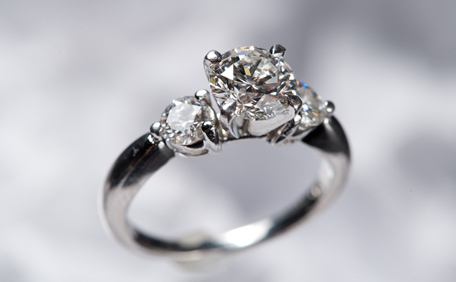As you’re shopping for a diamond, you’ve already heard about the importance of the 4Cs of diamond quality (color, clarity, cut, and carat weight) and the role they play in determining a diamond’s value. You may have also come across our post on diamond color charts, and are now looking for a diamond clarity chart to help you better understand and remember the clarity grade terms used by jewelers.
Well you’ve come to the right place. GIA’s clarity chart, better known as the Official GIA Diamond Clarity Scale, is the standard used by jewelers worldwide and is regarded as the best diamond clarity scale in the industry. GIA not only developed the diamond clarity scale and the grade terms on it, but – just as importantly – GIA also developed the grading practices and methodology needed to arrive at those clarity grades. Prior to GIA’s clarity grading system for diamonds, jewelers were using terms that were imprecise and easily misinterpreted, such as “loupe clean,” or “piqué.” Today, even if you buy a diamond in another part of the world, the jeweler will likely use GIA terms such as VVS1 or SI2, even if her language is French or Japanese instead of English.
For your convenience, here is the Official GIA Diamond Clarity Scale presented in three ways.
GIA Diamond Clarity Scale as Found on GIA Diamond Grading Reports
A diamond’s clarity, or its relative lack of inclusions and blemishes, is graded on a scale ranging from Flawless to Included. The size, number, position, relief, and the type of inclusion or blemish present, and how easily they can be seen at 10X magnification determine a diamond’s clarity grade. A Flawless grade means no inclusions or blemishes are visible at 10X magnification. While an I3 grade means that inclusions are obvious at 10X.
GIA diamond grading reports list a diamond’s clarity grade and also provide a clarity chart – known as the official GIA Diamond Clarity Scale – depicting the eleven clarity grades for natural diamond within the diamond clarity scale.
Interactive GIA Diamond Clarity Scale
Did you know that inclusions and blemishes have names – like feather, crystal, cloud, and bearded girdle, among others? These clarity characteristics are carefully mapped on the plotting diagram that accompanies every GIA Diamond Grading Report. Use this interactive diamond clarity scale to learn about the different types of blemishes and inclusions, their names, and how they might appear under magnification. Toggle through the examples, and mouse over the diamonds to see how blemishes and inclusions can impact a diamond’s appearance at each grade level on the diamond clarity scale. Just move the slider left to right on the scale. You can also swipe the diamond to see the plotting diagram from both views.
While it may appear that there is only a minor difference between the diamonds, these distinctions are actually very significant when it comes to diamond quality and cost. The diamond clarity plotting diagram blog post provides a deeper dive into clarity and how it is described on GIA reports.
Diamond Clarity Grading Video
Here’s another helpful way to deepen your understanding of diamond clarity and the GIA Diamond Clarity Scale. Watch this video to see how a diamond grader in the GIA laboratory uses 10X magnification to evaluate clarity and plot a diamond’s inclusions and blemishes.
If you found these variations of the diamond GIA Diamond Clarity Scale informative, informally known as the clarity chart, have a look at GIA’s blog posts that explain the 4Cs of diamond quality: Understanding the 4Cs of Diamond Quality and Diamond Cut Grading.
Main image courtesy of John O’Hara. Photo: Valerie Power/GIA.
